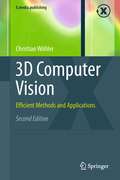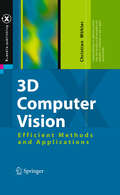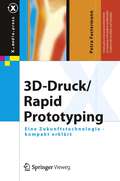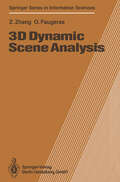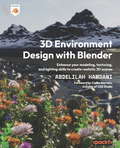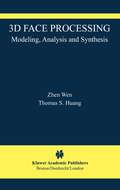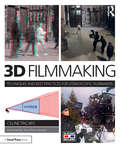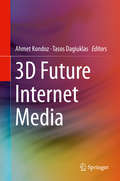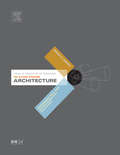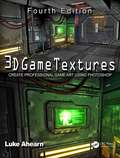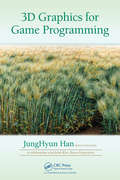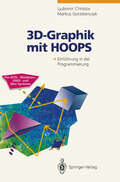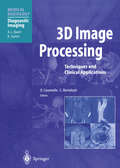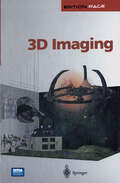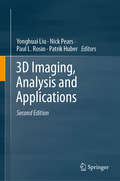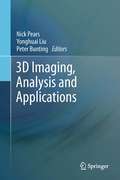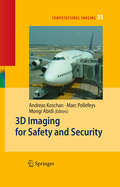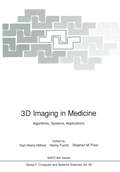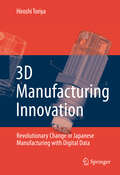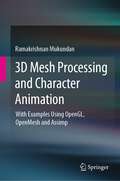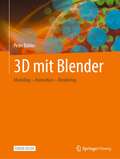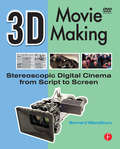- Table View
- List View
3D Computer Vision: Efficient Methods and Applications (X.media.publishing)
by Christian WöhlerThis indispensable text introduces the foundations of three-dimensional computer vision and describes recent contributions to the field. Fully revised and updated, this much-anticipated new edition reviews a range of triangulation-based methods, including linear and bundle adjustment based approaches to scene reconstruction and camera calibration, stereo vision, point cloud segmentation, and pose estimation of rigid, articulated, and flexible objects. Also covered are intensity-based techniques that evaluate the pixel grey values in the image to infer three-dimensional scene structure, and point spread function based approaches that exploit the effect of the optical system. The text shows how methods which integrate these concepts are able to increase reconstruction accuracy and robustness, describing applications in industrial quality inspection and metrology, human-robot interaction, and remote sensing.
3D Computer Vision: Efficient Methods and Applications (X.media.publishing)
by Christian WöhlerThis work provides an introduction to the foundations of three-dimensional c- puter vision and describes recent contributions to the ?eld, which are of methodical and application-speci?c nature. Each chapter of this work provides an extensive overview of the corresponding state of the art, into which a detailed description of new methods or evaluation results in application-speci?c systems is embedded. Geometric approaches to three-dimensional scene reconstruction (cf. Chapter 1) are primarily based on the concept of bundle adjustment, which has been developed more than 100 years ago in the domain of photogrammetry. The three-dimensional scene structure and the intrinsic and extrinsic camera parameters are determined such that the Euclidean backprojection error in the image plane is minimised, u- ally relying on a nonlinear optimisation procedure. In the ?eld of computer vision, an alternative framework based on projective geometry has emerged during the last two decades, which allows to use linear algebra techniques for three-dimensional scene reconstructionand camera calibration purposes. With special emphasis on the problems of stereo image analysis and camera calibration, these fairly different - proaches are related to each other in the presented work, and their advantages and drawbacks are stated. In this context, various state-of-the-artcamera calibration and self-calibration methods as well as recent contributions towards automated camera calibration systems are described. An overview of classical and new feature-based, correlation-based, dense, and spatio-temporal methods for establishing point c- respondences between pairs of stereo images is given.
3D-Druck/Rapid Prototyping: Eine Zukunftstechnologie - kompakt erklärt (X.media.press)
by Petra FastermannImmer mehr Kreative nutzen die Möglichkeit, eigene dreidimensionale Objekte in Kunststoff, Metall oder Keramik schnell und preisgünstig herstellen zu lassen. Der 3D-Druck ist eine revolutionäre Technologie, die dieVerwirklichung von Ideen ermöglicht. 3D-Drucker werden immer kleiner und leistungsstärker und damit bürotauglicher. Eine umfassende Beschreibung dieser Zukunftstechnologie bietet dieses praxisnahe und anwenderorientierte Buch. Dabei hilft es mit Tipps und Hinweisen bei der Auswahl des optimalen CAD-Programms und 3D-Druckers.
3D Dynamic Scene Analysis: A Stereo Based Approach (Springer Series in Information Sciences #27)
by Zhengyou Zhang Olivier Faugerashe problem of analyzing sequences of images to extract three-dimensional T motion and structure has been at the heart of the research in computer vi sion for many years. It is very important since its success or failure will determine whether or not vision can be used as a sensory process in reactive systems. The considerable research interest in this field has been motivated at least by the following two points: 1. The redundancy of information contained in time-varying images can over come several difficulties encountered in interpreting a single image. 2. There are a lot of important applications including automatic vehicle driv ing, traffic control, aerial surveillance, medical inspection and global model construction. However, there are many new problems which should be solved: how to effi ciently process the abundant information contained in time-varying images, how to model the change between images, how to model the uncertainty inherently associated with the imaging system and how to solve inverse problems which are generally ill-posed. There are of course many possibilities for attacking these problems and many more remain to be explored. We discuss a few of them in this book based on work carried out during the last five years in the Computer Vision and Robotics Group at INRIA (Institut National de Recherche en Informatique et en Automatique).
3d Environment Design With Blender: Enhance Your Modeling, Texturing, And Lighting Skills To Create Realistic 3d Scenes
by Abdelilah Hamdani Carlos BarretoEnhance your modeling, texturing, and lighting skills to create realistic 3D scenes
3D Face Processing: Modeling, Analysis and Synthesis (The International Series in Video Computing #8)
by Zhen Wen Thomas S. Huang3D Face Processing: Modeling, Analysis and Synthesis introduces the frontiers of 3D face processing techniques. It reviews existing 3D face processing techniques, including techniques for 3D face geometry modeling; 3D face motion modeling; and 3D face motion tracking and animation. Then it discusses a unified framework for face modeling, analysis and synthesis. In this framework, the authors present new methods for modeling complex natural facial motion, as well as face appearance variations due to illumination and subtle motion. Then the authors apply the framework to face tracking, expression recognition and face avatar for HCI interface. They conclude this book with comments on future work in the 3D face processing framework. 3D Face Processing: Modeling, Analysis and Synthesis will interest those working in face processing for intelligent human computer interaction and video surveillance. It contains a comprehensive survey on existing face processing techniques, which can serve as a reference for students and researchers. It also covers in-depth discussion on face motion analysis and synthesis algorithms, which will benefit more advanced graduate students and researchers.
3D Filmmaking: Techniques and Best Practices for Stereoscopic Filmmakers
by Celine TricartA visual book for the visual artist, 3D Filmmaking: Techniques and Best Practices for Stereoscopic Filmmakers provides a comprehensive overview of the theory, language, and methods behind stereoscopic 3D filmmaking, all in one package. Celebrated 3D filmmaker Celine Tricart explores every facet of the art, from the technical to the practical, including: 3D vision History of 3D cinema Stereoscopic basics and techniques How to shoot in 3D 3D VFXs, animation in 3D, and 2D to 3D conversion Live broadcast in 3D 3D viewing and projection 3D as a storytelling tool Screenwriting for 3D Working with a stereographer 3D storyboarding and previz 3D postproduction Sound design in-depth A must-read for any 3D filmmaker, producer, writer, or technician interested in the third dimension, 3D Filmmaking covers the history of the form, defines key 3D terms and places them into context, and offers lessons on using the medium as a visual storytelling tool, creating a perfect blend of concepts, practice, and history. Full color throughout, the book also includes a pair of 3D glasses for you to view the 3D images within, and each chapter features detailed color diagrams and examples in anaglyph 3D, as well as interviews with 3D visionaries like Jean Pierre Jeunet (Director, Amélie, Alien 4), Chris Sanders (Director, How to Train Your Dragon, The Croods), Demetri Portelli (Stereographer, Hugo), Phil McNally (Stereoscopic Supervisor, How to Train Your Dragon, Madagascar 4), Tim Webber (VFX supervisor, Gravity), Scott Farrar (VFX supervisor, the Transformers franchise), and Victoria Alonso (Stereoscopic Supervisor, Marvel Studios). A companion website (www.routledge.com/cw/tricart) features links to useful resources and footage from 3D films.
3D Filmmaking: Techniques and Best Practices for Stereoscopic Filmmakers
by Celine TricartA visual book for the visual artist, 3D Filmmaking: Techniques and Best Practices for Stereoscopic Filmmakers provides a comprehensive overview of the theory, language, and methods behind stereoscopic 3D filmmaking, all in one package. Celebrated 3D filmmaker Celine Tricart explores every facet of the art, from the technical to the practical, including: 3D vision History of 3D cinema Stereoscopic basics and techniques How to shoot in 3D 3D VFXs, animation in 3D, and 2D to 3D conversion Live broadcast in 3D 3D viewing and projection 3D as a storytelling tool Screenwriting for 3D Working with a stereographer 3D storyboarding and previz 3D postproduction Sound design in-depth A must-read for any 3D filmmaker, producer, writer, or technician interested in the third dimension, 3D Filmmaking covers the history of the form, defines key 3D terms and places them into context, and offers lessons on using the medium as a visual storytelling tool, creating a perfect blend of concepts, practice, and history. Full color throughout, the book also includes a pair of 3D glasses for you to view the 3D images within, and each chapter features detailed color diagrams and examples in anaglyph 3D, as well as interviews with 3D visionaries like Jean Pierre Jeunet (Director, Amélie, Alien 4), Chris Sanders (Director, How to Train Your Dragon, The Croods), Demetri Portelli (Stereographer, Hugo), Phil McNally (Stereoscopic Supervisor, How to Train Your Dragon, Madagascar 4), Tim Webber (VFX supervisor, Gravity), Scott Farrar (VFX supervisor, the Transformers franchise), and Victoria Alonso (Stereoscopic Supervisor, Marvel Studios). A companion website (www.routledge.com/cw/tricart) features links to useful resources and footage from 3D films.
3D Future Internet Media
by Ahmet Kondoz Tasos DagiuklasThis book describes recent innovations in 3D media and technologies, with coverage of 3D media capturing, processing, encoding, and adaptation, networking aspects for 3D Media, and quality of user experience (QoE). The main contributions are based on the results of the FP7 European Projects ROMEO, which focus on new methods for the compression and delivery of 3D multi-view video and spatial audio, as well as the optimization of networking and compression jointly across the Future Internet (www.ict-romeo.eu). The delivery of 3D media to individual users remains a highly challenging problem due to the large amount of data involved, diverse network characteristics and user terminal requirements, as well as the user’s context such as their preferences and location. As the number of visual views increases, current systems will struggle to meet the demanding requirements in terms of delivery of constant video quality to both fixed and mobile users. ROMEO will design and develop hybrid-networking solutions that combine the DVB-T2 and DVB-NGH broadcast access network technologies together with a QoE aware Peer-to-Peer (P2P) distribution system that operates over wired and wireless links. Live streaming 3D media needs to be received by collaborating users at the same time or with imperceptible delay to enable them to watch together while exchanging comments as if they were all in the same location.The volume provides state-of-the-art information on 3D multi-view video, spatial audio networking protocols for 3D media, P2P 3D media streaming, and 3D Media delivery across heterogeneous wireless networks among other topics. Graduate students and professionals in electrical engineering and computer science with an interest in 3D Future Internet Media will find this volume to be essential reading.
3D Game Engine Architecture: Engineering Real-Time Applications with Wild Magic
by David EberlyDave Eberly's 3D Game Engine Design was the first professional guide to the essential concepts and algorithms of real-time 3D engines and quickly became a classic of game development. Dave's new book 3D Game Engine Architecture continues the tradition with a comprehensive look at the software engineering and programming of 3D engines. This book is
3D Game Textures: Create Professional Game Art Using Photoshop
by Luke AhearnThe new edition of 3D Game Textures: Create Professional Game Art Using Photoshop features the most up-to-date techniques that allow you to create your own unique textures, shaders, and materials. Revised to take new technology into account, it is an ideal hands-on resource for creating online worlds, simulations, web-based applications, and architectural visualization projects. Continuing the practical, no-nonsense approach of its predecessors, the fourth edition shows you how to advance your digital art skills with textures and shaders by exploring their interactions in single objects or entire scenes. It contains expanded coverage of shader nodes, and the companion website—www.lukeahearn.com/textures—has been updated to include video tutorials as well as updated sample textures, shaders, materials, actions, brushes, and all of the art from the book.
3D Game Textures: Create Professional Game Art Using Photoshop
by Luke AhearnThe new edition of 3D Game Textures: Create Professional Game Art Using Photoshop features the most up-to-date techniques that allow you to create your own unique textures, shaders, and materials. Revised to take new technology into account, it is an ideal hands-on resource for creating online worlds, simulations, web-based applications, and architectural visualization projects. Continuing the practical, no-nonsense approach of its predecessors, the fourth edition shows you how to advance your digital art skills with textures and shaders by exploring their interactions in single objects or entire scenes. It contains expanded coverage of shader nodes, and the companion website—www.lukeahearn.com/textures—has been updated to include video tutorials as well as updated sample textures, shaders, materials, actions, brushes, and all of the art from the book.
3D Granny Squares: Crochet patterns and projects for pop-up granny squares
by Caitie Moore Sharna Moore Celine SemaanThe humble granny square gets a fresh new look in this collection of over 20 3D granny square crochet patterns all on the theme of food and drink. Please note that these patterns were previously published in 3D Granny Squares.Each motif features a 3D element that is integral to the food and drink granny square design and the squares can be used to make fun and unique blankets and throws, cute toys and accessories, the only limit is your imagination.This collection features 24 different designs for your favourite tasty treats, choose from a wide range of designs including a cherry pie, a piece of pizza, waffle, cupcake and a doughnut; or a selection of fruits including apple, strawberry, pineapple, and watermelon. There are also drinks such as milkshake, soda and coffee.As well as the granny square patterns there are also six bright and beautiful projects showing how to use the squares to make unique gifts for friends and family. These include a fun Pineapple Cushion, a cute Fried Egg Potholder, quick and easy Apple Coasters, a strawberry themed towel topper, a teapot pincushion and a cherry envelope pouch.Each granny square has the full written pattern plus large sized charts and all the stitches and techniques required are featured in the General Techniques section at the back of the book. The squares have been created by three of the biggest names in crochet: Celine Semaan, Sharna Moore and Caitie Moore, who have brought their flair and creativity to the designs.
3D Graphics for Game Programming
by JungHyun HanDesigned for advanced undergraduate and beginning graduate courses, 3D Graphics for Game Programming presents must-know information for success in interactive graphics. Assuming a minimal prerequisite understanding of vectors and matrices, it also provides sufficient mathematical background for game developers to combine their previous experie
3D-Graphik mit HOOPS: Einführung in die Programmierung
by Ljubomir Christov Markus GorzelanczykDieses Buch ist sowohl eine systematische Einführung in das 3D-Grafiksystem HOOPS (Hierarchical Object-Oriented Picture System) als auch ein ausführliches Handbuch für dessen Programmierung. Es wird vorausgesetzt, daß der Benutzer die Grundbegriffe der Computergrafik beherrscht. Der Neuling, der Hoops kennen- und nutzen lernen möchte, kann das Buch als Lehrbuch verwenden. Jedes Kapitel behandelt einen abgeschlossenen Aspekt von Hoops. Dabei werden die jeweils relevanten Prozeduren zusammengefaßt und kurz erläutert. Anschauliche Beispiele erleichtern das Verständnis. Der schon mit Hoops vertraute Leser kann das Buch als Nachschlagewerk für die Programmierung benutzen. Eine ausführliche Prozedur-Referenz rundet das Buch ab. Mit zahlreichen Programmierbeispielen in C.
3D Image Processing: Techniques and Clinical Applications (Medical Radiology)
by A. L. Baert D. Caramella C. BartolozziFew fields have witnessed such impressive advances as the application of computer technology to radiology. The progress achieved has revolutionized diagnosis and greatly facilitated treatment selection and accurate planning of procedures. This book, written by leading experts from many different countries, provides a comprehensive and up-to-date overview of the role of 3D image processing. The first section covers a wide range of technical aspects in an informative way. This is followed by the main section, in which the principal clinical applications are described and discussed in depth. To complete the picture, the final section focuses on recent developments in functional imaging and computer-aided surgery. This book will prove invaluable to all who have an interest in this complex but vitally important field.
3D Imaging, Analysis and Applications
by Yonghuai Liu Nick Pears Paul L. Rosin Patrik HuberThis textbook is designed for postgraduate studies in the field of 3D Computer Vision. It also provides a useful reference for industrial practitioners; for example, in the areas of 3D data capture, computer-aided geometric modelling and industrial quality assurance. This second edition is a significant upgrade of existing topics with novel findings. Additionally, it has new material covering consumer-grade RGB-D cameras, 3D morphable models, deep learning on 3D datasets, as well as new applications in the 3D digitization of cultural heritage and the 3D phenotyping of crops. Overall, the book covers three main areas: ● 3D imaging, including passive 3D imaging, active triangulation 3D imaging, active time-of-flight 3D imaging, consumer RGB-D cameras, and 3D data representation and visualisation; ● 3D shape analysis, including local descriptors, registration, matching, 3D morphable models, and deep learning on 3D datasets; and ● 3D applications, including 3D face recognition, cultural heritage and 3D phenotyping of plants. 3D computer vision is a rapidly advancing area in computer science. There are many real-world applications that demand high-performance 3D imaging and analysis and, as a result, many new techniques and commercial products have been developed. However, many challenges remain on how to analyse the captured data in a way that is sufficiently fast, robust and accurate for the application. Such challenges include metrology, semantic segmentation, classification and recognition. Thus, 3D imaging, analysis and their applications remain a highly-active research field that will continue to attract intensive attention from the research community with the ultimate goal of fully automating the 3D data capture, analysis and inference pipeline.
3D Imaging, Analysis and Applications
by Nick Pears, Yonghuai Liu and Peter Bunting3D Imaging, Analysis and Applications brings together core topics, both in terms of well-established fundamental techniques and the most promising recent techniques in the exciting field of 3D imaging and analysis. Many similar techniques are being used in a variety of subject areas and applications and the authors attempt to unify a range of related ideas. With contributions from high profile researchers and practitioners, the material presented is informative and authoritative and represents mainstream work and opinions within the community.Composed of three sections, the first examines 3D imaging and shape representation, the second, 3D shape analysis and processing, and the last section covers 3D imaging applications. Although 3D Imaging, Analysis and Applications is primarily a graduate text, aimed at masters-level and doctoral-level research students, much material is accessible to final-year undergraduate students. It will also serve as a reference text for professional academics, people working in commercial research and development labs and industrial practitioners.
3D Imaging for Safety and Security (Computational Imaging and Vision #35)
by Andreas Koschan Marc Pollefeys Mongi AbidiThis book presents the thoroughly revised versions of lectures given by leading researchers during the Workshop on Advanced 3D Imaging for Safety and Security in conjunction with the International Conference on Computer Vision and Pattern Recognition CVPR 2005, held in San Diego, CA, USA in June 2005. It covers the current state of the art in 3D imaging for safety and security.
3D Imaging in Medicine: Algorithms, Systems, Applications (NATO ASI Subseries F: #60)
by Karl H. Höhne Henry Fuchs Stephen M. PizerThe visualization of human anatomy for diagnostic, therapeutic, and educational pur poses has long been a challenge for scientists and artists. In vivo medical imaging could not be introduced until the discovery of X-rays by Wilhelm Conrad ROntgen in 1895. With the early medical imaging techniques which are still in use today, the three-dimensional reality of the human body can only be visualized in two-dimensional projections or cross-sections. Recently, biomedical engineering and computer science have begun to offer the potential of producing natural three-dimensional views of the human anatomy of living subjects. For a broad application of such technology, many scientific and engineering problems still have to be solved. In order to stimulate progress, the NATO Advanced Research Workshop in Travemiinde, West Germany, from June 25 to 29 was organized. It brought together approximately 50 experts in 3D-medical imaging from allover the world. Among the list of topics image acquisition was addressed first, since its quality decisively influences the quality of the 3D-images. For 3D-image generation - in distinction to 2D imaging - a decision has to be made as to which objects contained in the data set are to be visualized. Therefore special emphasis was laid on methods of object definition. For the final visualization of the segmented objects a large variety of visualization algorithms have been proposed in the past. The meeting assessed these techniques.
3D Manufacturing Innovation: Revolutionary Change in Japanese Manufacturing with Digital Data
by Hiroshi ToriyaFor a company to survive in the manufacturing industry, it must not only accumulate light-weight 3D data, but also share this information within the company and with related companies as well as train key personnel. 3D Manufacturing Innovation introduces the best practices developed by Toyota, Sony, Nikon, Casio and other pioneers in the global engineering scene, providing the reader with invaluable tips for manufacturing innovation.
3D Mesh Processing and Character Animation: With Examples Using OpenGL, OpenMesh and Assimp
by Ramakrishnan Mukundan3D Mesh Processing and Character Animation focusses specifically on topics that are important in three-dimensional modelling, surface design and real-time character animation. It provides an in-depth coverage of data structures and popular methods used in geometry processing, keyframe and inverse kinematics animations and shader based processing of mesh objects. It also introduces two powerful and versatile libraries, OpenMesh and Assimp, and demonstrates their usefulness through implementations of a wide range of algorithms in mesh processing and character animation respectively. This Textbook is written for students at an advanced undergraduate or postgraduate level who are interested in the study and development of graphics algorithms for three-dimensional mesh modeling and analysis, and animations of rigged character models. The key topics covered in the book are mesh data structures for processing adjacency queries, simplification and subdivision algorithms, mesh parameterization methods, 3D mesh morphing, skeletal animation, motion capture data, scene graphs, quaternions, inverse kinematics algorithms, OpenGL-4 tessellation and geometry shaders, geometry processing and terrain rendering.
3D mit Blender: Modeling – Animation – Rendering
by Peter BühlerDieses Buch ist der ideale Einstieg in die 3D-Modellierung und 3D-Animation mit dem Open-Source-Programm Blender. Anhand von Übungen mit leicht nachzuvollziehenden Schritt-für-Schritt-Anleitungen vermittelt es kompakt die wesentlichen Grundlagen der Arbeit mit Blender. Dank des durchdachten didaktischen Konzepts werden Ihnen Arbeitsschritte und Projektergebnisse praxisorientiert nähergebracht. Alle Anleitungen werden durchgängig mit hilfreichen Screenshots veranschaulicht. Nie war der Einstieg in Blender einfacher! Mit diesem Buch erhalten Sie eine fundierte Basis für die weitergehende Arbeit mit Blender.
3D Movie Making: Stereoscopic Digital Cinema from Script to Screen
by Bernard MendiburuHollywood is going 3D, read this book to understand why and how, and to secure your next job on a 3D movie. Making a 3D movie is much more than shooting with a 3D camera and showing it in a 3D theater. Each and every step of the movie production cycle will be affected by 3D, just like sound and color affected the whole industry. After an introduction on how the human brain perceive depth, this book explains, in a step-by-step approach, how 3D affects screen writing, art direction, principal photography, editing, visual effects and even movies distribution. It's a must read for anyone in the profession who wants to understand the next revolution in cinema. The DVD is not included with the E-book. Please contact the publisher for access to the DVD content by emailing d.mcgonagle@elsevier.com.
